How to Add Calculated Field in Pivot Table?
Calculated Field in Pivot Table marks the pinnacle of custom data analysis within your dynamic reports, enabling you to delve deeper into your datasets and uncover insights that lie beneath the surface. This powerful feature transforms your approach to data, allowing you to integrate custom calculations directly into your pivot tables, thereby refining your analysis and tailoring your findings to your specific needs. Embrace the sophistication of a Calculated Field in Pivot Table, and let it guide you towards more informed decisions and compelling data narratives, all while streamlining your analytical workflow.
After creating a pivot table, you frequently find that you need to broaden your research and incorporate additional data and calculations.
You don’t need to go back and add a new data point to the source data if you can get the additional data point you need by using the current data points in the pivot table. Instead, you can accomplish this using a Calculated Field in Pivot Table.
What is the calculated item in pivot table?
There is an opportunity to add more information or computations to the pivot table by using “Pivot Table Calculated Field.” For our reports, we frequently need to include our own unique computations that can make use of different fields in the data collection.
In the below example, Pivot Table summarizes the sales and profit values for the various items. By using “Pivot Table Calculated Field”, we can know what the profit margin of these items was (where the profit margin is ‘Profit’ divided by ‘Sales’)
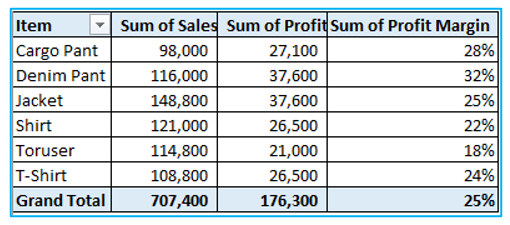
Add a calculated field in pivot table:
To insert calculated field, we need a pivot table. Suppose you have a Pivot Table as shown below and you want to calculate the profit margin for each item:
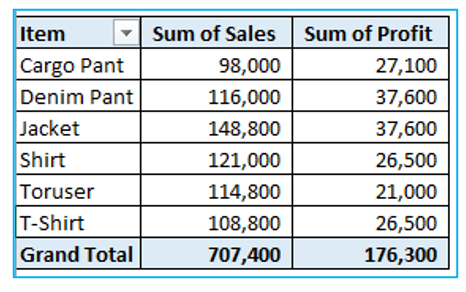
Procedure to create a calculated field in pivot table:
Step 1: In the Pivot Table, simply pick a cell, outlined in Red below.
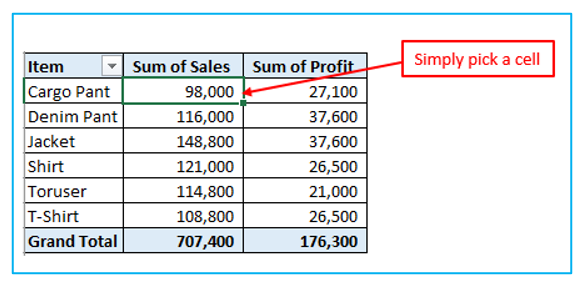
Step 2: Go to “PivotTable Tools” in Ribbon >> Analyze >> Fields, Items & Sets >> Calculated Field, outlined in Red below.

Step 3: Specify a name in the “Name” field of the “Insert Calculated Filed” dialog box for the new calculated field.
Create the formula you desire for the computed field in the Formula field. For determining profit margin, the formula is ‘= Profit/ Sales’. The field names can be entered manually or by double-clicking on the field name in the “Fields” box.
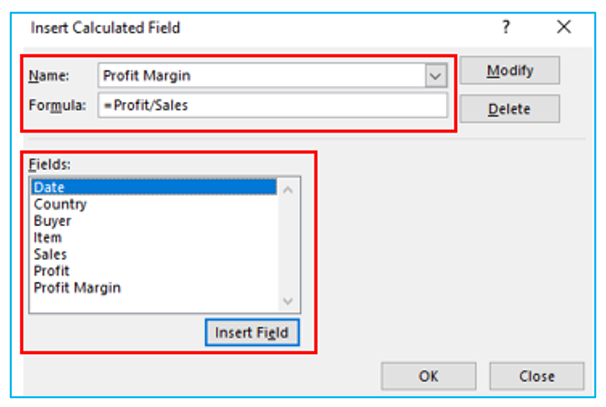
Step 4: After clicking on “Add” the dialog box will be closed. The Calculated Field will show up in the list of fields in the “PivotTable Fields” as soon as you add it, outlined in Red below
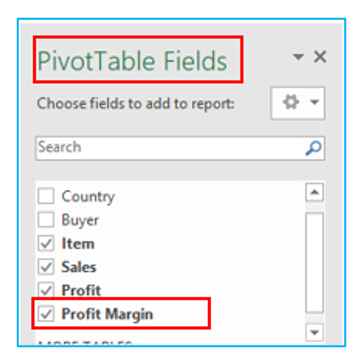
Step 5: The result looks like below. New column named “Sum of Profit Margin” is added, outlined in Red below.
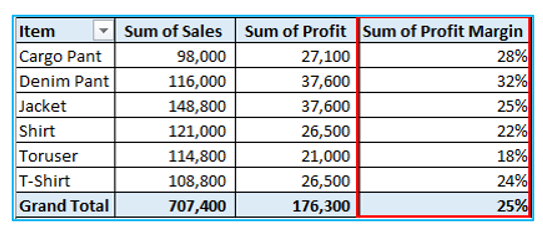
You may now use this calculated field just like any other field in a pivot table (note that you can not use Pivot Table Calculated Field as a report filter or slicer).
The advantage of utilizing a Calculated Field in Pivot Table is the ability to change the Pivot Table’s format and it will update seamlessly.
For example, in the case, if I drag and drop Buyer into the rows section, the result will look like
what is displayed below, with both the buyer and the item’s profit margin reported.
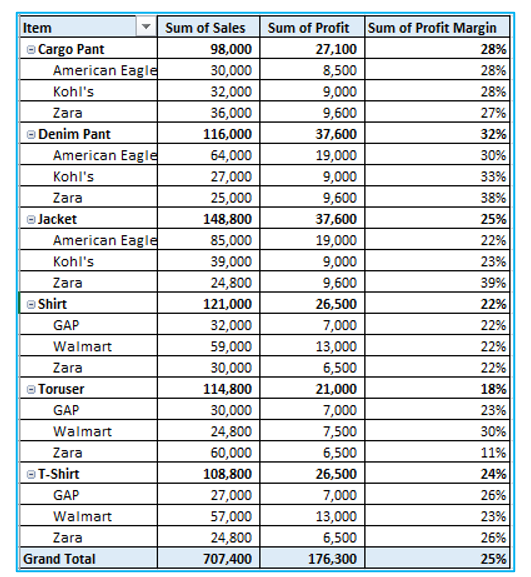
In pivot table calculated field, you can also use advanced formula. Before applying advanced formula, you must know some things, so you will not get any issues. They are:
- References and named ranges cannot be used when building a Pivot Table Calculated Field. That would eliminate many formulas, including VLOOKUP, INDEX, OFFSET, and others. You can, however, employ formulas that don’t require references (such SUM, IF, COUNT, and so on).
- In the formula, a constant may be used. For instance, you can use the calculation =Sales*1.1 to determine the sales that are anticipated to increase by 10%. (Where 1.1 is constant).
- The formula that creates the computed field adheres to the hierarchy of precedence. Use parenthesis as a best practice to ensure that you don’t have to remember the order of precedence.
How to modify or delete an Excel pivot table calculated field?
If you have a Pivot Table Calculated Field, you can modify the formula or delete it.
Modify or delete a pivot table calculated field to the Pivot Table:
Step 1: In the Pivot Table, simply pick a cell, outlined in Red below.
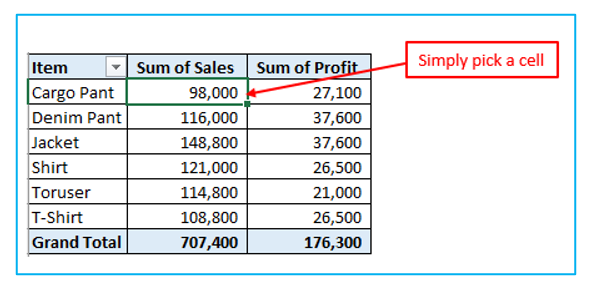
Step 2: Go to “PivotTable Tools” in Ribbon >> Analyze >> Fields, Items & Sets >> Calculated Field, outlined in Red below.

Step 3: In the “Name” field of the “Insert Calculated Filed” dialog box, click on the drop-down arrow (small downward arrow at the end of the field), outlined in Red below.
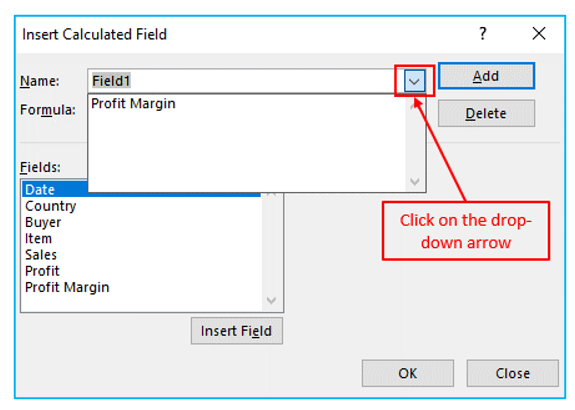
Step 4: After clicking click on the drop-down arrow, you can see the list. Choose the calculated field you would like to remove or modify from the list, outlined in Red below.
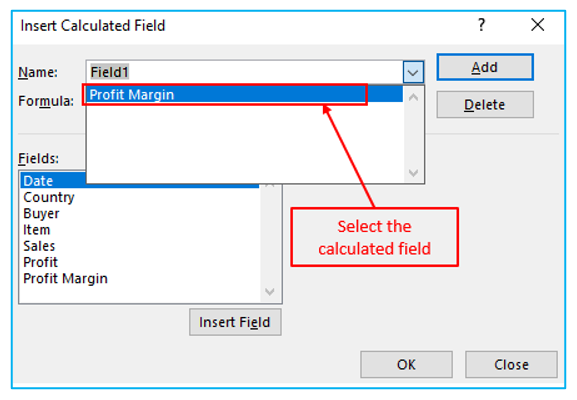
Step 5: If you want to change the formula, click on “Modify”, or if you want to delete it, click on “Delete”.
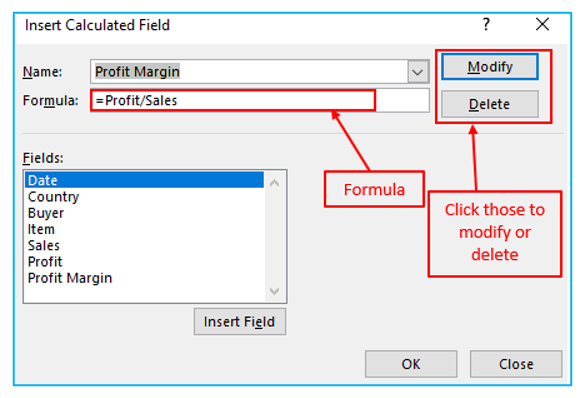
How to get a list of all the calculated field formulas in Pivot Table?
If you make a lot of Pivot Table Calculated fields, you shouldn’t worry about remembering the formulas that were used in each one.
You may rapidly compile a list of all the formulas used to produce Calculated Fields in Microsoft Excel.
Procedure of getting a list of all calculated field formulas:
Step 1: In the Pivot Table, simply pick a cell, outlined in Red below.
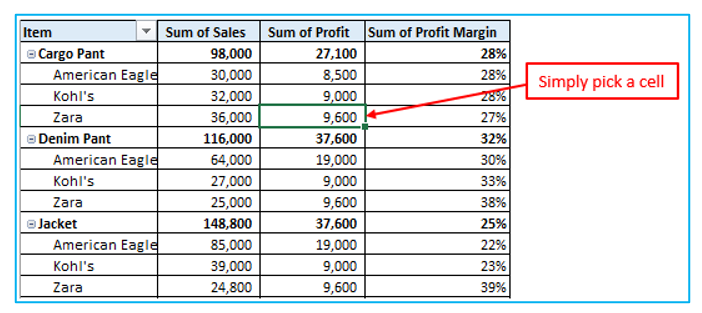
Step 2: Go to “PivotTable Tools” in Ribbon >> Analyze >> Fields, Items & Sets >> List Formulas, outlined in Red below.

Step 3: When you select List Formulas, Excel will immediately create a new worksheet with information about all the calculated fields and items you have used in the pivot table.
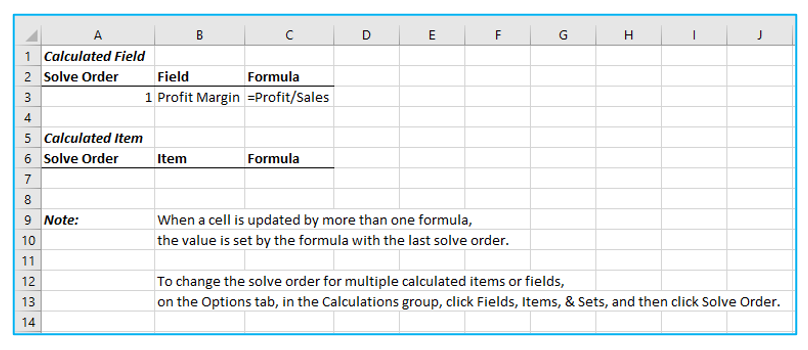
Add Calculated Fields in Pivot Table – Applications
- Custom Calculations Within Data Sets:
- Create custom formulas that are not present in the original dataset, such as profit margins or performance ratios, enabling a deeper level of analysis directly within the pivot table.
- Combining Data from Different Columns:
- Summarize or combine data from different columns in meaningful ways, like total sales by adding individual product sales, or calculating total expenses by summing various cost columns.
- Creating Dynamic Ratios and Percentages:
- Calculate ratios or percentages that reflect the relationship between data points, such as percentage of total sales, expense ratios, or completion percentages, providing insights into proportions and relationships within the data.
- Conditional Computations:
- Implement calculations that only apply under certain conditions, like bonuses awarded only if sales targets are met, or discounts applied based on order volume, adding a layer of conditional analysis to your data.
- Time-Based Calculations:
- Analyze changes over time by calculating differences or growth percentages between periods, such as month-over-month growth, or year-to-date sales comparisons.
- Performance Benchmarking:
- Compare actual performance against targets or benchmarks by creating calculated fields in pivot table for variances or performance indexes, offering a clear and concise way to measure success and identify areas for improvement.
Calculated Fields in Pivot Tables are incredibly versatile, enhancing the power and flexibility of your data analysis, and enabling you to derive customized insights directly from your pivot table setup.
For ready-to-use Dashboard Templates:
